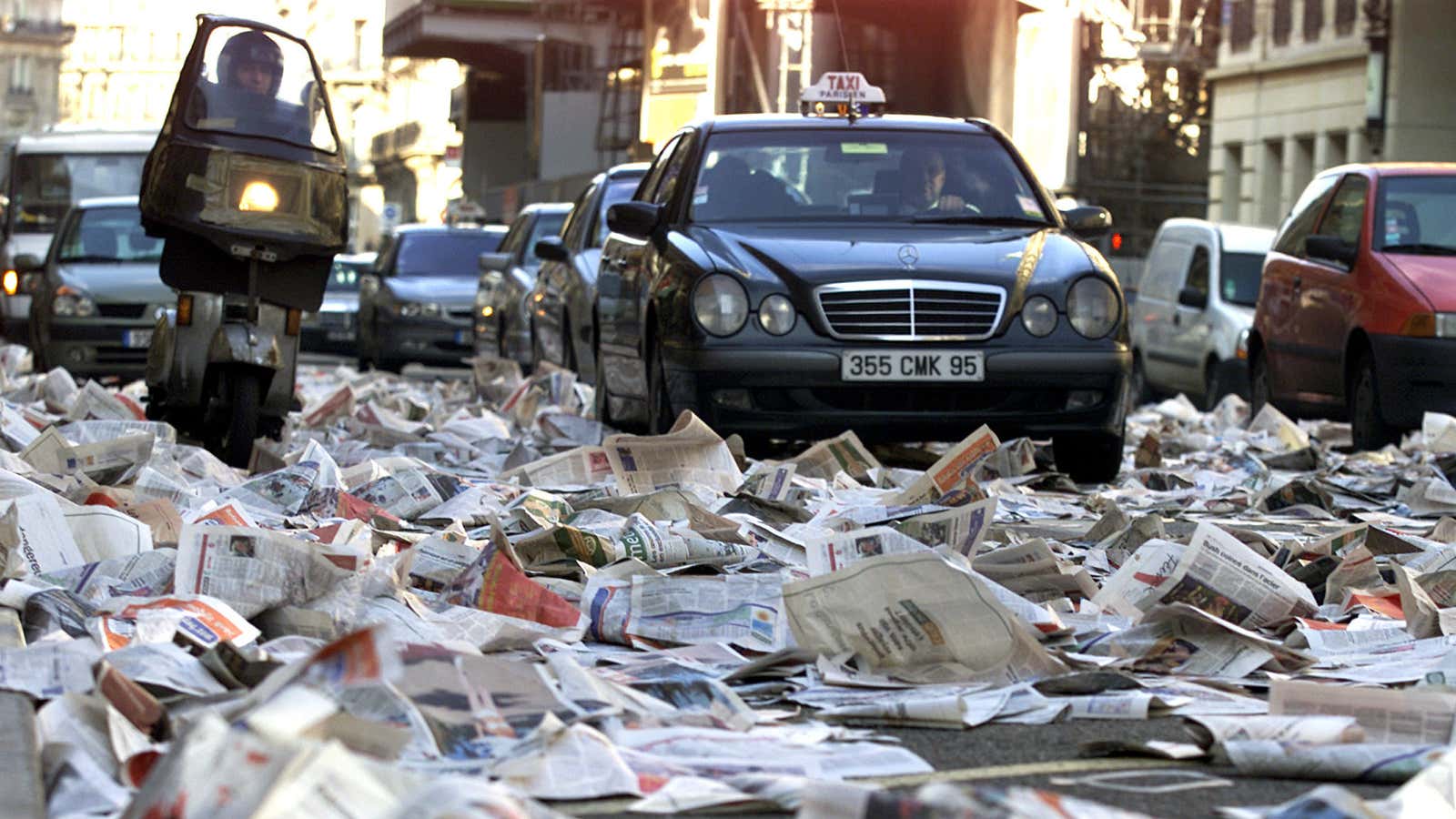Collecting eyeballs is a diversion of publisher resources. As the ad model loses steam, focusing on page views generates less and less value and leads to commoditized, lowest-common-denominator news content. It’s time to look for alternate models.
Whether you read tech or media news through a RSS reader, or by directly accessing websites, you end up flipping through the same headlines. In the news business, duplication and commoditization have reached unprecedented levels.
As an example, take Techmeme’s aggregation of Microsoft’s A.I. Twitter bot snafu. For this subject, Techmeme harvested no less than 70 specifics URLs (as measured Sunday at about 2:30 a.m. PDT). And this is just a small slice of total coverage, for a story that certainly isn’t this year’s biggest. This explains the traction of a service like Nuzzel which, among other things, de-duplicates similar analyses thanks to a clever social voting algorithm.
What we face today is a vast stream of replicated information, packaged in myriads of slightly different ways, but sharing a common objective: collecting and retaining viewers at all costs.
Costs actually keep shooting higher. When looking under a website’s hood, you’ll see dozens of trackers tied to a clickbait-related system designed to optimize or measure the impact of contents. Embedded in the code of native mobile apps, these tracking features generate server requests that further slow down the display of legit contents—hence the success of AMP, the stripped-down version of HTML created by Google.
The audience-building process is shifting its focus from quality to unabated eyeball collection tactics, with pernicious consequences.
For one, a clickbait engine is expensive to operate. Sophisticated analytics now blended with powerful A/B testing solutions absorb hundreds of thousands of dollars in running costs when you add license fees, costs of system setup, and wages for the qualified people who operate them.
Two, it destroys value. Eyeball-attracting editing obeys rules defined by algorithms. Problem: these systems are so widespread that they generate uniformity from media—which, in turn, leads to severe value depletion.
A Google News search for “Tay Bot” (in reference to Microsoft’s Twitter blunder) will yield 3,720 results, and a “Racist Bot” query will collect 22,600 articles. Back in the days of printed media, a topic of similar importance would have created no more than a hundred articles. Today, media outlets launched by a six-person newsroom will all address the same subject, using the same audience-boosting technologies and roughly similar headlines. There is no hope of drawing sizable value from such overabundance where too many players provide the same service.
Clickbait systems also affect journalism. Instead of writers being judged by their ability to produce original, solid reporting, preferably unseen before, many advertising-dependent publishers now must feed the beast with a lineup of digital serfs selected for their output volume rather than reporting skills.
I’m not condemning this evolution—I harbor no nostalgia for the old days. I actually think it is great to have technically-savvy journalists, more connected to their audience than they used to be. I’m simply stating a mere fact: today’s pressure for producing large numbers of stories leads to their loss of value per unit. This is incompatible with in-depth journalism that requires time, persistence, and vision.
How can we exit of such a toxic system?
I see three major options.
The first one is what I’ll call “newsroom partition”—one in which the mandatory clickbait operation is separated from a smaller unit that produces value-added journalism. This is the choice made by BuzzFeed, the poster child of scientific clickbait tactics. Three years ago, BuzzFeed’s editor Ben Smith hired Mark Schoofs from ProPublica. Schoofs won a Pulitzer Prize in 2000 for a series on AIDS in Africa while working at the Village Voice (he later joined the Wall Street Journal before heading to ProPublica.) “BuzzFeed offered him a better salary, but money was not the point,” an insider told me. “What decided him to switch was the job description: He was to build a large team of investigative reporting, with great means and freedom.” There is no doubt that BuzzFeed will snatch a Pulitzer in years to come—even if the work of Mark Schoofs’ team accounts for a tiny fraction (probably less of one percent) of BuzzFeed’s overall page views.
Another efficient way to limit clickbait effects is the paid-for model. Unfortunately the ad-only business model has shown its limits when it comes to supporting quality reporting. The colossal losses at The Guardian—bleeding money at a rate of about £1 million per week ($1.41 million)—are a painful reminder that great, wide-spectrum journalism only supported by advertising no longer works, and that other options need to be contemplated. As explained in this piece of the FT.com (paywall, precisely), other models are under consideration :
To restore profitability, the Guardian aims to double reader revenues by 2019—from their current level of £30 million—partly through its membership scheme, through which readers can pay between £5 and £60 a month to support its editorial independence and access events.
This option bears lots of uncertainties: I can’t think of a single publisher able to squeeze a significant amount of money from membership. Maybe The Guardian will crack the code on this one. As for the NYTimes, it would be severely in the red without the €200 million ($225 million) a year in digital subscriptions. (In a future Monday Note, we’ll explore the sustainability of small, paid-for high quality news operations such as The Information.)
The last alternative is non-profit, philanthropy-supported journalism. ProPublica and The Center for Public Integrity show a promising path in terms of ambition and quality (they got a Pulitzer prize in 2011 and 2014 respectively). But this model remains unique to the United States where both the culture and a vast pool of philanthropy have no equivalent elsewhere.
This post originally appeared at Monday Note.




